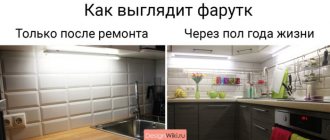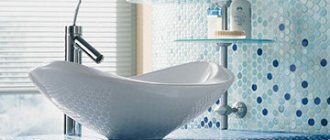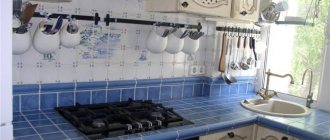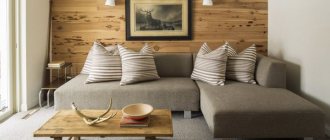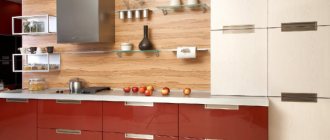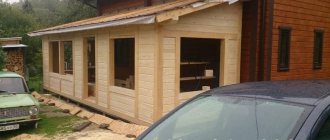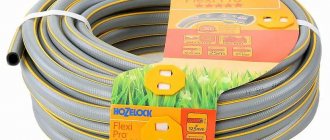Quote from Goodwine
Read in full In your quotation book or community!
Skinali or ceramic tiles?
Choosing a kitchen apron. When renovating a kitchen, it's usually the big, complex issues that take the spotlight, such as choosing the color of the kitchen panels or waterproofing the floor. There are, however, small details in which forgetfulness or carelessness can be quite costly - things that we do not concentrate on, thinking that they will solve themselves. This area also includes such an “uninteresting” problem as choosing an apron for a kitchen set, that is, designing a space that begins directly where the edge of the countertop touches the wall. What awaits us on this kitchen “horizon”? Let's try to figure it out together.
Tiled apron
A backsplash, as commonly understood, is the part of the wall between the lower and upper kitchen cabinets. It would seem, why make additional decoration for part of the wall if you can decorate everything at once, comprehensively, with beautiful wallpaper, paint or textured plaster? However, the kitchen is more a functional room than a decorative one; splashes of fat and boiling water, drops of vegetable and meat juice, small pieces of food flying off during the cutting process naturally fall on the nearest wall. Thus, the most important properties of an apron are hygiene, durability, resistance to washing and cleaning, and low moisture absorption. The apron is usually not made too high - since the area of \u200b\u200b“danger” is quite small. The approximate height from the edge of the tabletop is 40-60 cm, if you do not have upper cabinets, or the entire space between the upper and lower parts of the set. If you use panels made of plastic, MDF, wood, tiles or mosaics, then you need to install a special plinth at the junction of the apron and the countertop to prevent moisture and dirt from flowing into the gap.
Finishing with MDF panels
When choosing material for an apron, some people immediately make their task easier by purchasing wall panels along with the kitchen itself. Many middle and economy class manufacturers provide this opportunity, offering ready-made panels to match the selected set of furniture, with the height and width already selected according to the dimensions of the kitchen units. Such aprons are installed along with the furniture and are most often made of MDF - that is, the same material as the surfaces of kitchen cabinets. MDF panels can be very attractive in appearance - this material can imitate various textures and be available in all colors of the rainbow. Such panels are inexpensive and easy to install, and if necessary, they can be easily replaced with new ones. It is important that they do not require additional preparation of the wall before installation. It is believed that MDF panels are extremely resistant to abrasion and caustic substances, although, in fact, they can quickly lose their “sales appearance”, depending on the texture. It is not recommended to use MDF panels near the stove.
Modern kitchen with an apron made of MDF panels
Backlight
A white apron with lighting looks especially impressive. The most common lighting option is to install lamps with directional light directly above the apron. Such lighting will allow you to illuminate the work area in a directional manner and will not shine into the eyes of those sitting at the table.
White apron with lighting in a white kitchen.
If there are wall cabinets above the apron, then lamps placed on the bottom of the cabinets will be more convenient. It is better to choose LED strip or fluorescent lamps for these purposes - they provide more uniform illumination. Spotlights are too bright and will reflect unattractively on a glossy surface as blinding spots.
Lamps located at the bottom of the cabinets are a convenient placement option.
For glass skinals, the backlight can be of 2 types:
- The LED strip is attached to the top and bottom of the panels. For this, a special aluminum profile with channels for LED strip and wiring is used. The thin and narrow profile does not catch the eye.
- The backlight can be attached to the back of the glass panel, which is moved away from the wall using remote holders. The LED strip is recessed into a niche. This lighting looks very modern - in the form of a clear luminous strip.
A white apron looks most impressive with lighting.
In a modern minimalist kitchen with a white monochrome apron, colored LED lighting with RGB tape - purple, blue, green, red - will look good. Using the remote control, you can control the installation of a dynamic mode with changing colors or other effects, or fixing a specific one color.
Purple LED lighting in the kitchen with a white backsplash.
Tiled apron
Another classic option is a tile backsplash. A tiled apron requires preparation of the wall for finishing. The process of laying tiles is standard, with the only difference being that in this case the tiles are placed on a strictly verified area of space. The tiled apron must be ready in advance, at the finishing stage, by the time the set is assembled. The tile is practical - it can be easily cleaned from any kind of dirt, stains, dust; visually it always looks more expensive and hygienic than MDF panels. You can “play” with the design of the backsplash - choose tiles with a metallic coating, mosaic tiles, lay borders, make inserts from mirror tiles, etc. However, it is important that the apron matches the color and style with your future kitchen.
Design tips for combining a white apron with other shades
- Black tones in the kitchen interior are ideally combined with a white apron. This color scheme is typical for the Art Nouveau style, but in others it is used less often. A light apron looks especially elegant in combination with white walls and black furniture.
- Combining with red will help create a contrasting and stylish room, where this piece of furniture will be very appropriate and will ideally set off the facades of the set.
- A white apron will optimally dilute the green color scheme of the interior.
- In a plain, light kitchen, you should not use such a color scheme, otherwise the room will turn into a solid white spot.
A white apron goes well with many bright and rich colors in kitchen design: lilac, orange, blue and blue, brown and yellow. The main thing is to minimize light elements in kitchens in which pastel (milky, beige) and natural tones (wood, stone, sea wave, etc.) predominate, otherwise the room will become one merging spot and will not have its own individuality and uniqueness.
Mosaic apron
An option for a tiled apron is a mosaic insert, an expensive luxury option. A mosaic apron will fit well into a classic or “antique” style kitchen. It should be noted that laying mosaics is a labor-intensive process and requires great skill. As in the case of tiles, a mosaic apron, laid out before installing a kitchen, requires preparation and leveling of the wall surface.
Mosaic in the kitchen
What styles would a white apron look good in?
Many fashionable and popular stylistic trends today include a light color scheme due to its universal compatibility with many shades and textures:
- Classic. A warm white palette will look good in such a kitchen, and an apron made in this color will fit perfectly into its functional area. It will harmonize perfectly with a white chandelier, chairs or curtains. In general, this color is most suitable for a classic kitchen, especially in combination with gray and black.
- Those who don’t like classics, but want something unusual and original, choose ethnic style in kitchen design. Here, a white apron will look unexpectedly calm and harmonious in combination with a set or dining set in a bold color scheme.
- Aprons of this tone are often installed in kitchens designed in the Art Nouveau .
- High tech. A white room in this style looks advantageous and impressive. This apron can advantageously emphasize the strict geometric theme of the headset. Even a small kitchen in which this element is installed will be visually more spacious.
- Provence. This style also cannot exist without white. With a lilac or beige, blue or light blue set, or a dining room group, the apron will look relevant and correct.
According to many designers, in white this decorative element looks good in any kitchen style - in minimalism, Scandinavian, rustic, baroque style it will always be in place.
Steel
In a kitchen styled like futurism, minimalism, hi-tech, etc., in the kitchen corner of a loft, wall panels made of smooth hardened steel would look quite appropriate. This is a hygienic, durable, inexpensive and easy to install apron that is resistant to all types of kitchen stains and high temperatures. The downside of this material may be its inappropriateness in most interior styles. Sometimes a steel apron is installed “spotwise” - for example, for protection in the slab area, and the remaining space is finished with tiles or mosaics.
Steel apron
Pros and cons of PVC
Polyvinyl chloride used for finishing work is the most budget-friendly plastic material. This is the easiest option for installation, because... There is no need to pre-prepare the surface and all work can be done independently. PVC is distinguished by a wealth of colors, prints, the presence of voluminous details, and there are even transparent options. This type has a number of significant disadvantages:
- It is not resistant to abrasion, and this characteristic is very important for a kitchen apron.
- It loses strength at a considerable rate, therefore, it will not last long.
- The use of detergents and exposure to light quickly leads to loss of presentability.
- There are gaps between the panels that allow moisture to penetrate, creating ideal conditions for mold to grow.
- Contact with fire is prohibited.
- Environmentally unsafe - may release harmful substances.
Attention! There are also safe options for PVC panels. When purchasing material, you must look at the quality certificate.
Glass kitchen apron
An interesting and unusual replacement for a tile backsplash is panels made of tempered glass (skinali), which appeared on the market relatively recently and are quickly becoming fashionable. In addition to various texture options, glass panels can be painted on the reverse side in any color or decorated with a pattern of your choice. Double-layer sandwich panels provide the ability to insert a photograph or drawing between them, which may suit a kitchen of a certain style.
The advantages of skinali are durability, unusual and beautiful appearance, giving the kitchen a certain chic, resistance to washing and cleaning, low moisture absorption. Glass panels are quite easily attached to a regular wall and, like MDF panels, do not require special preparation or cleaning of the surface. They can be installed on walls that are not perfectly level. Among the disadvantages of a glass apron is that such panels should be washed as thoroughly as windows, because after the usual careless “wiping”, visible smudges and stains will remain. Panels of transparent glass are often used, applied to the surface of untreated stone or a brick wall - this creates the necessary atmosphere without the disadvantages inherent in porous materials.
Bright glass apron in the kitchen
Ceramic tiles as finishing for the work area
This option can be safely called the most traditional and most popular. The reason for this is an extremely successful combination of user qualities, exceptional diversity and quite affordable cost. The main feature of the material is its low porosity. And since there are no pores, moisture will not be absorbed and bacteria will not multiply.
This option has a lot of advantages, so this type of cladding has been done and will continue to be done for a long time.
- Practicality . Ceramics absorb water no more than 2–3% of the volume. This means that the tiles are insensitive to steam and water, do not accumulate dirt, do not absorb grease, and can be washed with one swipe of a sponge. If this was not enough, then you can use any household chemicals: ceramics are only afraid of hydrofluoric acid.
- Durability - tiles can only be destroyed with a strong blow. It does not chip and is scratched with great difficulty.
- Ceramics are non-flammable , which is important in the kitchen: after all, there is a source of open fire.
- The decorative possibilities are almost limitless. Tiles can be single- or multi-colored, include ornaments and images; be matte, glossy, pearlescent, imitate metal, wood and stone, and so on. And this, in turn, opens up enormous design opportunities: by choosing the right combination of tiles, you can visually expand the kitchen space and raise the ceiling. Increase the distance between the upper and lower sets, structure an excessively long wall, etc.
The photo shows an apron made of single-color and patterned tiles.
The disadvantages of a ceramic tile backsplash include the difficulty of installation. Tiles are not flexible, so the surface under the ceramics must be perfectly flat. And styling is best done by professionals; there are many subtleties in this matter.
A natural stone
An apron made of natural stone is an option for an eco-style kitchen, for interiors in the spirit of boho, Provence, and neo-medieval. It looks very decorative, is very durable and heat-resistant. However, the uneven and rather porous surface of the stone, depending on your activity and neatness in the kitchen, may require increased care and additional polishing. In addition, natural stone is heavy and additionally absorbs moisture.
Apron made of natural stone
Design ideas
In order for such a finish to look stylish and not cheapen the interior, it is better to pay attention to options with natural wood finishes: wood, marble, stone, brick. A light sheet with marble “veins” looks especially relevant. The main thing is to choose textures and images that are as close to natural as possible. In one version, imitation wood can look very natural, but in another it can look completely unnatural. The colors should not be too bright, and the top layer should not be glossy. Matte surfaces look better because glare and reflections will give off unnaturalness. As for texture, there are options for panels with a rough finish. In this design, the imitation of rocks looks quite natural.
Instagram @schmidt_officiel
Instagram @rkply01
ShutterStock
You should also give preference to monochromatic options or simple geometry, imitation tiles, bricks. It is better to choose sheets that cover the entire length of the working surface, so that there are no unnecessary joints (it is simply impossible to glue sheets so that the seams are not visible, but it looks ugly, besides, moisture will get into the joints, and the coating will quickly become unusable) . For this reason, it is worth abandoning PVC tiles, which are glued to the wall like ordinary ceramic ones.
Instagram @tepian.living
Instagram @riko.ua
Instagram @demiliodesign
Instagram @_magnoliahome
Polycarbonate cladding can be used in different ways, by gluing it on top of wallpaper, a painted wall, or masonry made of natural stone or wood. The glossy glass finish looks good in minimalist and modern kitchens.
ShutterStock
ShutterStock
Instagram @rkply01
- Kitchen
How to decorate the walls in the kitchen: 11 materials and examples of their use
Fake diamond
An apron made of artificial stone is often made fused with the countertop - the surfaces simply blend into one another, which is extremely convenient, hygienic and practical, although quite restrained in terms of aesthetics. Artificial stone panels can also be used to decorate an apron in the “traditional” way - they are lighter and easier to install than fragile and heavy natural stone, and much more cost-effective. Using artificial stone, for example, lithoceramics, you can create an apron that not only imitates the surface of untreated stone, but also, for example, a “marble” or “granite” apron for a luxurious kitchen in classic, empire, and minimalist-chic styles.
Commonly used types of stones for aprons
Onyx is very beautiful and very expensive. Huge variety of colors available. This stone is a little transparent. A wow effect will be achieved if you highlight the corresponding area using an LED strip. The onyx apron seems very bright, even too colorful. Therefore, other interior items should be as neutral as possible.
Marble is also very beautiful: it is delicate and translucent. But this material is quite porous: it absorbs fat and is susceptible to staining. Therefore, the surface needs timely cleaning and regular treatment with mastic.
Granite is very strong and easy to maintain. But finding a beautiful color is very difficult.
There are red, blue, green options, but they are very expensive. In addition, granite is characterized by low radiation emission. Therefore, when purchasing, be sure to ask to see certificates.
Quartzite looks aesthetically pleasing and high-status. It is easy to care for. The stone pleases the eye with its pearlescent luster and variegated color. But it is not transparent and costs more than onyx.
Acrylic stone, from which countertops are also made, copes well with the tasks facing the apron. Unlike its natural counterpart, this is a fairly light material, which allows you to attach the slabs to the wall without any problems. Acrylic looks very aesthetically pleasing. This coating has an external resemblance to natural stone. The thickness of the panels is about 12 mm. For comparison, analogues made from quartz agglomerate reach 15-20 mm.
According to its properties, acrylic is very close to plastic. This material is warm to the touch, easy to install and easy to maintain. It is durable, has a wide range of colors, and is also resistant to mechanical and temperature influences and is not afraid of moisture. The surface is easy to restore if small scratches appear.
In addition to acrylic, quartz agglomerate is also used. It consists of 90% natural mineral chips, therefore it has the maximum external resemblance to an array of natural stone. Like its natural counterpart, quartz agglomerate is cold to the touch. It has all the advantages of acrylic: ease of care, perfectly smooth surface, hygiene (mold, mildew, microorganisms do not “take it”), flexibility in processing. In addition, it is characterized by resistance to mechanical stress and heat. Any colors are possible.
The disadvantages of quartz agglomerate are fear of abrasive agents, fading under the influence of ultraviolet radiation and large mass. In terms of weight, it does not differ from natural wood. The cost of this material is higher than acrylic.
The flexible stone has a texture similar to its natural counterpart. It is usually made on the basis of sandstone, and may also contain marble or granite chips. The mineral component is applied to the fiberglass. This stone is non-flammable, non-toxic, durable, withstands temperature changes well, has excellent flexibility and is easy to install. The main disadvantage is the high price.
Natural wood
Natural wood is not the most popular material for a kitchen apron, but it is used in interiors in the spirit of Provence, rustic, and “Russian style.” Wooden panels are usually stacked panels made from planks of hardwood. They should not be used near the stove; in addition, they are very difficult to clean from dirt, are not moisture resistant, and careless movement of a sharp kitchen appliance can make a dent in the soft surface of the wood. However, wooden panels create a unique comfort and microclimate in any room, including, of course, the kitchen. You should be careful with special impregnations that protect wood from warping when exposed to moisture and other external phenomena: when heated, a panel soaked in chemicals may begin to evaporate them outward, so this should not be done.
Wooden apron
What kitchen sets does stone go with?
Stone, whatever it is, even acrylic, is a stone in appearance. That is, he looks stern. This means that the kitchen set itself and the dining area furniture must match.
If you put a stone slab on the apron, then throw away the wooden stools with decorative cushions, and also take the Polish kitchen wall with MDF facades to the landfill.
Furniture should be natural and expensive. Otherwise, nothing good will come of your idea. We saw how eerie natural granite looks coupled with the most ordinary furnishings and curtains in the style of “Baba Klava’s”. Therefore, we warn you a second time: think and evaluate your capabilities.
Imagine how all this will look as a whole, and not separately. If what we write does not concern you in any way and you have top-class furniture, then let’s figure out which stone is better to take.
Plastic panels
I would also like to dwell on such an economical scheme for the kitchen as installing a set to a wall that is entirely pre-finished with plastic panels - a cheap and popular way to decorate walls. Plastic panels, like any panel-type materials, do not require finishing of the wall behind them, they are flexible, which means they fit the most curved wall - and, finally, they are cheaper and more accessible than any other material mentioned. However, these panels are not heat-resistant and get dirty very quickly. In addition, attaching kitchen cabinets to the wall will be very difficult, as will installing baseboards - the panels are attached at some distance from the wall.
What to choose for your kitchen
Every owner of a house or apartment wants to have a kitchen with an original, impressive design. This is why many people decide to buy skinals to finish the walls above the kitchen work area. Glass panels with original colors or unique patterns will effectively complement the interior or even become its highlight. Having decided to order a glass apron, you can be sure that the design of the room will have a beautiful look, similar to the design of an experienced designer, which will not go unnoticed by your guests.
Typically, custom-made skins are installed by the company that created them. This is exactly the approach our company Skinali-Fresh provides by creating kitchen glass aprons and installing them. Installation of the panels is carried out quickly, does not lead to severe contamination of the room, and therefore can be carried out even after the completion of the repair.
Kitchen island
What if your kitchen is an “island” that is not against the wall? Here you should adhere to the following rule: islands are made “double”, that is, twice as wide as a regular cabinet, and equipped with kitchen equipment on both sides. The “apron” becomes, as it were, an invisible detail, redundant, since there is simply no wall that needs protection from splashes and stains, and when working at the kitchen table, every time you stand with your back to the rest of the space and have enough space in front of you so that grease and the boiling water did not reach the floor. The second, less standard option is a false wall, whose height ends where the apron should end.
Kitchen with false wall
Why do you need (or not need) a stone apron?
In our opinion, it is needed solely for visual effect. An apron is the kind of thing that no one hits with axes when cutting meat, no one drops heavy cast-iron pans on it, and no one puts a boiling kettle on it.
That is, all the advantages of stone (namely, strength) are a completely pointless bonus for an apron.
The apron should only be heat-resistant and easily washable from drops of grease. Yes, stone also has these properties (and not everyone does, but more on that below), but other materials also have them. More affordable and more beautiful!
Can the boring colors of ordinary granite or gray chips of artificial stone compare with the most interesting Italian tiles? No, it can't.
Of course, if you take onyx or colored granite (for example, malachite color), then maybe it will look interesting. But, the price of onyx is such that very, very few people take it, and colored granite - you just can’t find it during the day and, again, it costs prohibitively.
As a rule, they take the most ordinary artificial stone, acrylic, which from a distance looks like a piece of plastic, but is not a stone. This “splendor” is used to anoint the apron, make a tabletop, and even cast sinks from it.
In our very humble opinion, it looks ugly and so standard (downright indecently standard) that kitchens from the times of the USSR come to mind, with identical sets throughout the vast Motherland. But then people had no choice, but now they do.
Apron color
In conclusion, I would like to say a few words about the color scheme of kitchen aprons. It is believed that the shade of the apron should be 1-2 tones darker than the color of the front kitchen panels, contrast with it or completely match (as sometimes happens, for example, with all-metal kitchen sets with steel trim). The color of the apron must be selected taking into account the color of the countertop. You should not decorate both the surfaces of the kitchen blocks and the surface of the apron with pronounced patterns or designs. It is also not recommended to make a very light apron in a dark kitchen with dark walls.
At what height should the apron be located?
Typically, the height of the apron depends on the size and dimensions of the kitchen unit - everything is individual, since kitchens are most often made to order. But there are also standards. The recommended minimum apron height for the kitchen is 45 cm, and the maximum is 56 cm.
But here again, it all depends on how convenient it will be for the hostess and family members. If everyone is short, it is better not to make the apron high. But don’t hang it too low either - there should be space above the worktop.
The only adequate requirement for a kitchen apron is that the edges of the finishing material should extend under the countertop and the lower edges of wall cabinets by about a couple of centimeters.
Check out our work

